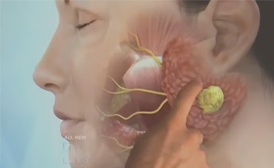The thyroid gland during the embryo’s development forms next to the back portion of the tongue and gradually descends down to the lower neck where it remains through out life. Sometimes when the thyroid is moving downwards it leaves a tract or duct in its path that does not disappear and stays open. This duct is a blind-ended pouch that can fill with fluid (cyst). It is called a Thyroglossal Duct Cyst (Figures 1-4). The cyst can become infected which will appear as a swollen, red and tender bump in the middle of the neck (Figure 5).
THYROGLOSSAL DUCT CYSTS


The treatment of the infected cyst is antibiotics, but the treatment of choice for a thyroglossal duct cyst is surgical removal (Sistrunk Procedure). This involves the removal of the infected cyst, along with any associated thyroglossal tissue, specifically the entire tract, that may cause recurrent infection. The rate of recurrence after a Sistrunk procedure is significantly lower than that following a simple cyst excision. This is an outpatient procedure, and patients are able to eat, and resume function immediately after surgery.
Branchial Cleft Cysts
The branchial arches are gill-like structures along the sides of the neck that appear in the embryo during the fourth or fifth week of pregnancy and form various parts of the head and neck. Normally, prior to birth, these structures are no longer present, but in some cases, pockets, or cysts, of this tissue will remain open because of abnormal fusion of these various parts. These cyst usually have a tract or duct that opens in the throat and occasionally in the ear are called Branchial Cleft Cysts. During childhood or early adolescence, these cysts may fill with fluid or become infected. This problem appears as a small lump or mass in the neck . A branchial cleft cyst will appear at the side of the neck and in rare cases, may appear on both sides.
Branchial cleft cysts are addressed by surgically removing cyst and its tract when the either cause recurrent infections or when they become large. Recurrence of infection after excision of a branchial cleft cyst is rare.
Schedule a Thyroglossal Duct Cysts or Branchial Cleft Cysts Consultation With Dr. Larian Today
To learn more about these and other types of head/neck surgery, contact our Los Angeles-area practice in Beverly Hills, serving all of Southern California. Call 310.461.0300!
© 2025 CENTER for Advanced Head & Neck Surgery All Rights Reserved. By Babak Larian, MD FACS
The information available on this website is provided for informational purposes only. This information is not intended to replace a medical consultation where a physician's judgment may advise you about specific disorders, conditions, and or treatment options. We hope the information will be useful for you to become more educated about your health care decisions.




